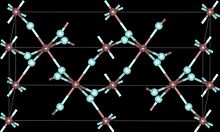Gallium(III) fluoride
 | |
 | |
| Names | |
|---|---|
| Other names gallium trifluoride | |
| Identifiers | |
CAS Number |
|
3D model (JSmol) |
|
| ChemSpider |
|
| ECHA InfoCard | 100.029.094 |
| EC Number |
|
PubChem CID |
|
| UNII |
|
CompTox Dashboard (EPA) |
|
InChI
| |
| |
| Properties | |
Chemical formula | GaF3 |
| Molar mass | 126.718 g/mol |
| Appearance | white powder |
| Density | 4.47 g/cm3 |
| Melting point | 800 °C (1,470 °F; 1,070 K) |
| Boiling point | 1,000 °C (1,830 °F; 1,270 K) |
Solubility in water | 0.0002 g/100 mL |
| Structure | |
Crystal structure | Rhombohedral, hR24 |
Space group | R-3c, No. 167 |
| Hazards | |
| GHS labelling: | |
Pictograms |  |
| Warning | |
| H302, H312, H332 | |
| P261, P264, P270, P271, P280, P301+P312, P302+P352, P304+P312, P304+P340, P312, P322, P330, P363, P501 | |
| NFPA 704 (fire diamond) |  3 0 0 |
Except where otherwise noted, data are given for materials in their standard state (at 25 °C [77 °F], 100 kPa).  N verify (what is N verify (what is  Y Y N ?) N ?) Infobox references | |
Chemical compound
Gallium(III) fluoride (GaF3) is a chemical compound. It is a white solid that melts under pressure above 1000 °C but sublimes around 950 °C. It has the FeF3 structure where the gallium atoms are 6-coordinate.[1] GaF3 can be prepared by reacting F2 or HF with Ga2O3 or by thermal decomposition of (NH4)3GaF6.[2] GaF3 is virtually insoluble in water.[2] Solutions of GaF3 in HF can be evaporated to form the trihydrate, GaF3·3H2O, which on heating gives a hydrated form of GaF2(OH).[2] Gallium(III) fluoride reacts with mineral acids to form hydrofluoric acid.
 |  |  |  |
| view along the a axis | view along the c axis | Ga coordination | F coordination |
References
- ^ Greenwood, Norman N.; Earnshaw, Alan (1997). Chemistry of the Elements (2nd ed.). Butterworth-Heinemann. ISBN 978-0-08-037941-8.
- ^ a b c Anthony John Downs, (1993), Chemistry of Aluminium, Gallium, Indium, and Thallium, Springer, ISBN 978-0-7514-0103-5
Further reading
- Barrière, A.S.; Couturier, G.; Gevers, G.; Guégan, H.; Seguelond, T.; Thabti, A.; Bertault, D. (1989). "Preparation and characterization of gallium(III) fluoride thin films". Thin Solid Films. 173 (2): 243. Bibcode:1989TSF...173..243B. doi:10.1016/0040-6090(89)90140-5.
- v
- t
- e
- Mg5Ga2
- GaS
- GaSe
- GaTe
- GaCl2
| Organogallium(III) compounds |
|---|











